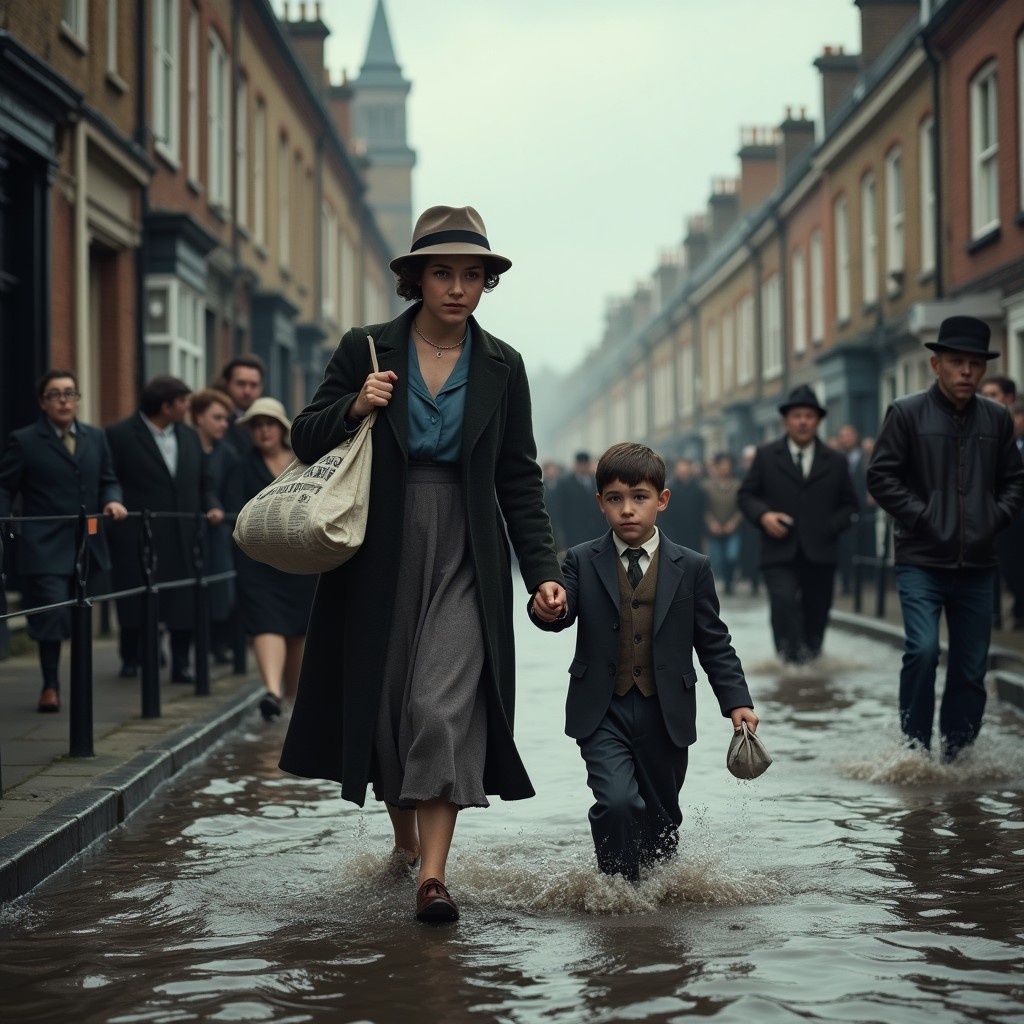7 Ianuarie 1928: Against the River's Wrath: Eleanor's Unyielding Journey Through London's Great Flood
**Title: The Rising Tide**
The air was heavy with anticipation as London awoke on January 7, 1928. The city, shrouded in a cloak of gray, seemed to hold its breath, waiting for the inevitable. The River Thames, swollen with the weight of melting snow and relentless rain, whispered ominously against its embankments.

Amidst the tension, in a modest flat on Millbank, Eleanor Harrington peered out of her window, her heart echoing the river's turbulent rhythm. She was a woman of quiet strength, her life a tapestry of resilience woven through years of hardship. Widowed during the Great War, Eleanor had found solace in her work as a seamstress, her needle stitching not just fabric, but the fabric of her life back together. "Ma, the river looks angry today," young Tommy, her ten-year-old son, remarked, his nose pressed against the cold glass. Eleanor turned to him, her face a mask of calm despite the unease curling in her stomach. "It's just the rain, love. It will pass." But even as she spoke, the distant rumble of the river seemed to grow louder, a beast awakening from its slumber. The streets below were a blur of activity, neighbors exchanging worried glances, their voices hushed but urgent.

As the morning wore on, the tension in the air thickened. Eleanor tried to focus on her sewing, the rhythmic motion of the needle a balm to her nerves. But the river's growl was relentless, a constant reminder of the danger lurking just beyond her door. By midday, the first screams pierced the air, a chilling symphony of panic and despair. Eleanor rushed to the window, her heart plummeting as she saw the river breaching its banks, water surging into the streets with a terrifying ferocity. "Tommy, we have to go!" she cried, her voice steady despite the chaos unfolding around them. Grabbing a small bag of essentials, Eleanor took Tommy's hand, her grip firm and reassuring. They joined the throng of people fleeing their homes, the water rising around them like a living thing, hungry and unstoppable.

The streets were a nightmare of swirling currents and desperate faces. Eleanor fought to keep her footing, her mind a whirl of fear and determination. She clung to Tommy, her resolve as unyielding as the river's advance. As they reached higher ground, Eleanor paused, breathless and trembling. Around her, the city was a tableau of devastation, the floodwaters claiming everything in their path. But in that moment, Eleanor felt a flicker of hope, a spark of defiance against the river's wrath. "We'll rebuild," she whispered to Tommy, her voice fierce with conviction. "We'll make it through this, just like we always have." Tommy nodded, his eyes wide but trusting. "I know we will, Ma." In the days that followed, the floodwaters receded, leaving behind a landscape forever altered. The city mourned its losses, but amidst the ruins, a spirit of resilience emerged. Communities banded together, their shared struggle forging bonds stronger than the river's fury. Eleanor and Tommy found shelter with neighbors, their lives uprooted but their spirits unbroken. As the city began to rebuild, Eleanor's hands, so skilled at mending fabric, turned to mending lives, her strength a beacon for those around her. The flood had taken much, but it had also given—a reminder of the fragility of life, and the power of unity in the face of adversity. And as the city rose from the waters, Eleanor knew that she and Tommy would rise with it, their future as boundless as the river's tide.

Amidst the tension, in a modest flat on Millbank, Eleanor Harrington peered out of her window, her heart echoing the river's turbulent rhythm. She was a woman of quiet strength, her life a tapestry of resilience woven through years of hardship. Widowed during the Great War, Eleanor had found solace in her work as a seamstress, her needle stitching not just fabric, but the fabric of her life back together. "Ma, the river looks angry today," young Tommy, her ten-year-old son, remarked, his nose pressed against the cold glass. Eleanor turned to him, her face a mask of calm despite the unease curling in her stomach. "It's just the rain, love. It will pass." But even as she spoke, the distant rumble of the river seemed to grow louder, a beast awakening from its slumber. The streets below were a blur of activity, neighbors exchanging worried glances, their voices hushed but urgent.

As the morning wore on, the tension in the air thickened. Eleanor tried to focus on her sewing, the rhythmic motion of the needle a balm to her nerves. But the river's growl was relentless, a constant reminder of the danger lurking just beyond her door. By midday, the first screams pierced the air, a chilling symphony of panic and despair. Eleanor rushed to the window, her heart plummeting as she saw the river breaching its banks, water surging into the streets with a terrifying ferocity. "Tommy, we have to go!" she cried, her voice steady despite the chaos unfolding around them. Grabbing a small bag of essentials, Eleanor took Tommy's hand, her grip firm and reassuring. They joined the throng of people fleeing their homes, the water rising around them like a living thing, hungry and unstoppable.

The streets were a nightmare of swirling currents and desperate faces. Eleanor fought to keep her footing, her mind a whirl of fear and determination. She clung to Tommy, her resolve as unyielding as the river's advance. As they reached higher ground, Eleanor paused, breathless and trembling. Around her, the city was a tableau of devastation, the floodwaters claiming everything in their path. But in that moment, Eleanor felt a flicker of hope, a spark of defiance against the river's wrath. "We'll rebuild," she whispered to Tommy, her voice fierce with conviction. "We'll make it through this, just like we always have." Tommy nodded, his eyes wide but trusting. "I know we will, Ma." In the days that followed, the floodwaters receded, leaving behind a landscape forever altered. The city mourned its losses, but amidst the ruins, a spirit of resilience emerged. Communities banded together, their shared struggle forging bonds stronger than the river's fury. Eleanor and Tommy found shelter with neighbors, their lives uprooted but their spirits unbroken. As the city began to rebuild, Eleanor's hands, so skilled at mending fabric, turned to mending lives, her strength a beacon for those around her. The flood had taken much, but it had also given—a reminder of the fragility of life, and the power of unity in the face of adversity. And as the city rose from the waters, Eleanor knew that she and Tommy would rise with it, their future as boundless as the river's tide.
The 1928 Thames flood was a catastrophic event that struck London on January 7, 1928, when the River Thames overflowed, inundating much of the riverside and causing significant damage. Triggered by a combination of heavy snowmelt, intense rainfall, and a storm surge, the floodwaters breached the Thames Embankment, leading to the deaths of 14 people and leaving thousands homeless. This disaster highlighted the vulnerabilities of London's flood defenses and, along with the North Sea flood of 1953, prompted the development of new flood control measures, culminating in the construction of the Thames Barrier in the 1970s. The flood also led to significant urban redevelopment in affected areas, transforming Millbank and reinforcing London's river defenses.


Comments
Post a Comment